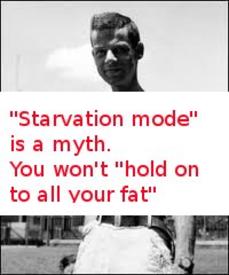Heart Rate Monitor - calorie count

yarwell
Posts: 10,477 Member
I sat here on the PC for 15 mins and told the Polar F6 I was "exercising". My heart rate averaged 41% of max with a peak of 45% of max. It says I used 23 calories.
So that's 92 calories an hour, or 2208 per day, sat using a PC. My BMR guesstimates are around 1620 so a ratio to BMR of 2208 / 1620 = 1.36 (less if sleep is taken into account at presumably a lower heart rate).
Do HRMs always include the energy you would have spent anyway sat doing nothing in their "exercise calories" ?
So that's 92 calories an hour, or 2208 per day, sat using a PC. My BMR guesstimates are around 1620 so a ratio to BMR of 2208 / 1620 = 1.36 (less if sleep is taken into account at presumably a lower heart rate).
Do HRMs always include the energy you would have spent anyway sat doing nothing in their "exercise calories" ?
0
Replies
-
Not too sure but curious as to what you were looking at to get that rise in heart rate.0
-
Subscribe to this topic.0
-
LOL. I think that was just random wanderings in my heart rate, 41 +/- 4 is probably my sitting resting rate.Not too sure but curious as to what you were looking at to get that rise in heart rate.0 -
I sat here on the PC for 15 mins and told the Polar F6 I was "exercising". My heart rate averaged 41% of max with a peak of 45% of max. It says I used 23 calories.
So that's 92 calories an hour, or 2208 per day, sat using a PC. My BMR guesstimates are around 1620 so a ratio to BMR of 2208 / 1620 = 1.36 (less if sleep is taken into account at presumably a lower heart rate).
Do HRMs always include the energy you would have spent anyway sat doing nothing in their "exercise calories" ?
HRMs just register the calories via how fast your heart is beating.
Quick example: I run 7 miles outside, my heartrate averaged for the whole run 160 bpm, in that session I burned 718 calories.
Yesterday, I ran 7 miles on the treadmill, my heartrate averaged for the whole run 148bpm, in that session I burned 551 calories.
The HRM does NOT subtract the amount of calories I would have burned during that time anyway, it just registers what I burned via my heartbeat for that time.
Word of warning too, HRMs are notoriously inaccurate when used when a person's heartrate is less than around 90 to 100bpm.0 -
Word of warning too, HRMs are notoriously inaccurate when used when a person's heartrate is less than around 90 to 100bpm.
Great Protip. Thanks!0 -
Thanks, I had read stuff where they only recorded calories above a certain heart rate as being in "exercise mode" which fits with what you say.Word of warning too, HRMs are notoriously inaccurate when used when a person's heartrate is less than around 90 to 100bpm.
I can see how it would deceiving to add what this is telling me to MFP as "calories burned" for sure. I think I'll read the manual again, there is some stuff about "zones" I didn't take in first time.0 -
The Polar Rep told me to always turn off or pause the HRM if I am under 60% of max. He said to use percent of maximum as the gauge, not bpm. At the gym, I always have between 60-80% of maximum heart rate during my workout. If it goes under, I pause it.
I never go under, though lol
lol
EDIT: This is for fat loss. I do go over 60-80 % for fitness but when focusing on fat loss, I should be under 80, and he said to cycle between 60 and 80, don't stay constant.... 0
0 -
I can see how it would deceiving to add what this is telling me to MFP as "calories burned" for sure. I think I'll read the manual again, there is some stuff about "zones" I didn't take in first time.
The zones are the fat burn zone, the fitness improving zone and the maximum performance zone..
See this:
http://www.polar.fi/en/training_with_polar/training_articles/maximize_performance/running/polar_sport_zones_for_running0 -
I worked out I would burn about 58 calories an hour doing nothing, so I deduct this from my HRM's calories burned estimate.
If it says I burned 367 calories in 30 minutes of running, I record 337.0 -
I worked out I would burn about 58 calories an hour doing nothing, so I deduct this from my HRM's calories burned estimate.
If it says I burned 367 calories in 30 minutes of running, I record 337.
I do this also. I subtract 70 calories/hr from the exercise total0 -
Seems I can define a heart rate zone for exercise and it will tell me the time spent in that zone as well as the total. Subtracting a base load seems a sensible approach.0
-
Yes!Do HRMs always include the energy you would have spent anyway sat doing nothing in their "exercise calories" ?
I've worn my HRM (Polar FT4) for three hours while I was working (i.e. sitting at my lap top, getting up and going to the bathroom, going up and down stairs for drinks etc) on a number of occasions. I've also worn it going into work on the train when I've been sat motionless, half-asleep, and I've been able to calculate my true BMR and AMR from these readings and thus my AMR/min.
After I've exercised, I subtract my AMR from any HRM readings and/or MFP values.
Now, given that HRMs calculate calories burnt based on heart rate readings, it could be that these readings are less accurate when not actually increasing your heart rate through exercise, and perhaps the AMR deficit is technically negligible, but I'm anal enough to want to do all the maths anyhow :happy:0
This discussion has been closed.
Categories
- All Categories
- 1.4M Health, Wellness and Goals
- 398.2K Introduce Yourself
- 44.7K Getting Started
- 261K Health and Weight Loss
- 176.4K Food and Nutrition
- 47.7K Recipes
- 233K Fitness and Exercise
- 462 Sleep, Mindfulness and Overall Wellness
- 6.5K Goal: Maintaining Weight
- 8.7K Goal: Gaining Weight and Body Building
- 153.5K Motivation and Support
- 8.4K Challenges
- 1.4K Debate Club
- 96.5K Chit-Chat
- 2.6K Fun and Games
- 4.8K MyFitnessPal Information
- 12 News and Announcements
- 21 MyFitnessPal Academy
- 1.6K Feature Suggestions and Ideas
- 3.2K MyFitnessPal Tech Support Questions






